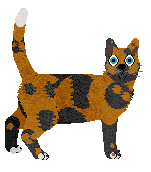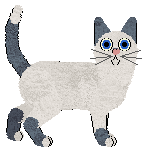










Tabby: Any of the tabby combinations, including silver and golden tabby.
Tortoishell: Any of the tortoiseshell combinations. This breed often has larger patches on the head/neck than the body; this is not a fault.
Torbie: Any of the torbie combinations of the allowed tabby combinations. This breed often has larger patches on the head/neck than the body; this is not a fault.
Smoke/Shaded/Chinchilla: Any of the above listed colours in any of the patterns, silver or gold base.
Colourpoint/Himalayan: Any of the colourpoint patterns.
Mink: Any of the mink patterns.
Burmese: Any of the burmese patterns.
White Patterns: Any of the above colours or patterns with tuxedo, bicolour, harlequin, or van white markings.
All colours may have "Ojos trait markings" which include
 markings on the tail tip, face, muzzle, and/or toes. It is not required for trait markings to include all of these areas; also, trait markings can be unevenly distributed as they do not follow typical white distribution rules.
markings on the tail tip, face, muzzle, and/or toes. It is not required for trait markings to include all of these areas; also, trait markings can be unevenly distributed as they do not follow typical white distribution rules. Catz with more white than tuxedo must have a white tail tip and four white feet; they may also have 50% or more white on the tail. Colourpoint and mink catz must have at least trait markings. A white chest spot is faulted on an otherwise solid or only trait-marked cat.
Bicolours are slightly less preferred than catz with only trait markings.



 or
or 

